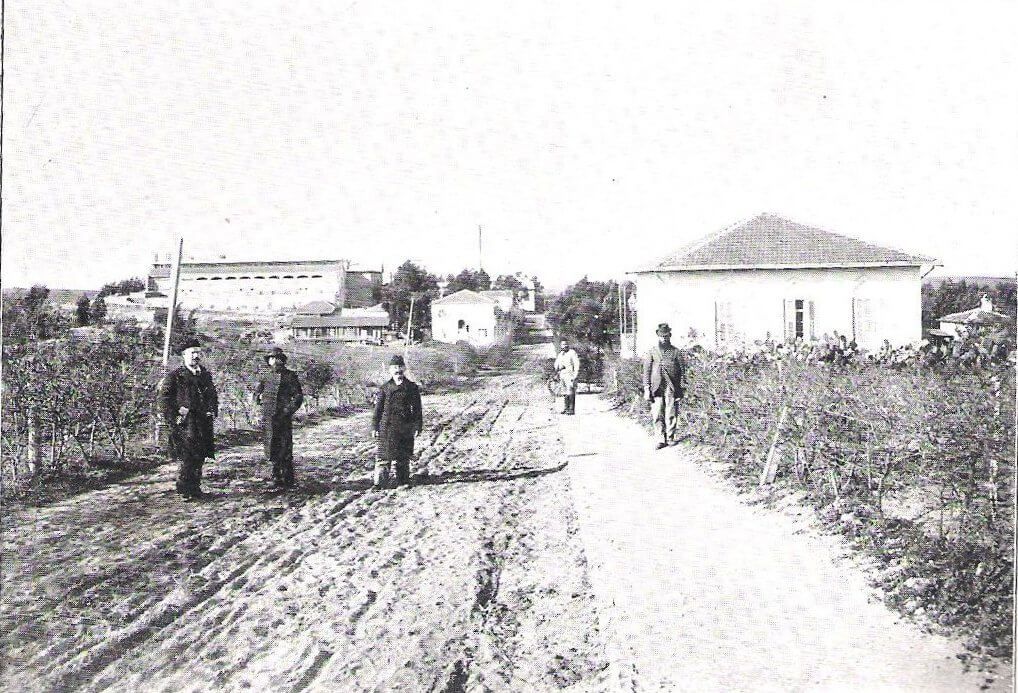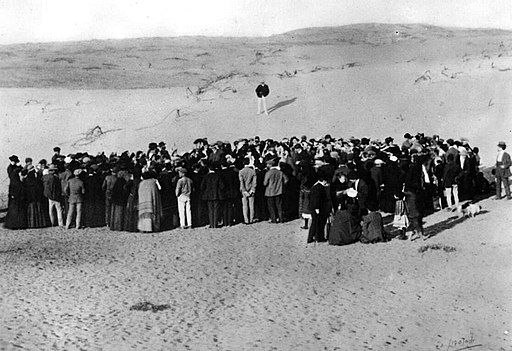The Land of Israel, known as Palestine at the time, was a wasteland in the late 19th century. Mark Twain visited the region in 1867 and wrote in his travel book The Innocents Abroad:
Of all the lands there are for dismal scenery, I think Palestine must be the prince. The hills are barren, they are dull of color, they are unpicturesque in shape. The valleys are unsightly deserts fringed with a feeble vegetation that has an expression about it of being sorrowful and despondent.… It is a hopeless, dreary, heart-broken land.
Small shreds and patches of it must be very beautiful in the full flush of spring, however, and all the more beautiful by contrast with the far-reaching desolation that surrounds them on every side.…
Palestine sits in sackcloth and ashes. Over it broods the spell of a curse that has withered its fields and fettered its energies.… Renowned Jerusalem itself, the stateliest name in history, has lost its ancient grandeur, and is become a pauper village…the wonderful temple, which was the pride and the glory of Israel, is gone.… The noted Sea of Galilee…was long ago deserted by the devotees of war and commerce, and its borders are a silent wilderness.…Palestine is desolate and unlovely.
Just 100 years later, the Land of Israel was filled with lush forests with trees and flowers growing throughout the country, surrounding heavily populated cities connected by congested highways.
Join the fight for Israel’s fair coverage in the news
When and how did this change transpire?
It’s important to emphasize that there was a continued presence of Jews in Palestine from the time of the destruction of the Temple in 70 CE and throughout the ensuing 2,000 years. The first major emigration of Jews to their homeland took place in the wake of the 1492 Spanish Inquisition, in which Jews were forced to either convert to Christianity or be expelled from Spain. Then in the late 18th century and early 19th century, very religious Eastern European Jews returned to the Land of Israel, not to build a state but to be the spiritual emissaries in the Holy Land for Jews throughout the world.
Despite the Arab population’s persecution of the Jews, in adherence to the Muslim institution of “dhimmitude,” referring to infidels who are not Muslim, who according to their faith must remain inferior to the Muslims, Jews continued to emigrate to Palestine and by 1840 they numbered 17,000 in Jerusalem – a majority of the city’s population.
Related reading: The Jewish Connection to the Land of Israel
Return to Zion
Then, in the mid-1800s, the Jewish people began the process of truly rebuilding their desolate homeland and creating a structured society. In 1855, Sir Moses Montefiore purchased land for Jewish homes west of Jerusalem’s Old City walls. Today they are the neighborhoods of Mishkenot Shaananim and Yemin Moshe, marked by the legendary Montefiore windmill. In 1854, Jerusalem’s Jewish community opened two hospitals – Bikur Cholim Hospital and Misgav Ladach Hospital. By 1868, Jerusalem had 21 synagogues.
A reawakening of interest in emigrating to Palestine emerged among Eastern European Jews in the late 1800s and between 1881 and 1903, tens of thousands made their way to Palestine in what became known as “the First Aliyah.”
These people, along with the help of the Jews previously living there and with the financial assistance of Baron Edmond de Rothschild, began farming the land and building agricultural settlements. These included Gadera, Rishon LeZion, Zichron Yaakov, Rosh Pina, Metulla, Hadera, Rehovot, Ness Ziona, and Petah Tikva, which began as farming settlements, eventually becoming neighborhoods of Tel Aviv.

It is critical to emphasize that all this took place before there was an entity called Political Zionism.
Once Political Zionism and the official effort to establish a state began at the very end of the 19th century, the drive to physically regrow this desolate wasteland and build a structured society in this land, which had nothing of the sort for thousands of years, continued with full steam.
The Second Aliyah, from the beginning of the 20th century until World War I, was mostly made up of Jews who saw labor as the highest of ideals, and led to the emigration of another 35,000 Jews and the establishment of agricultural communes called “Kibbutzim.” These Jews drained swamps, cleared rocks, plowed barren land, and planted trees. In 1908, Jews moved to sand dunes north of Jaffa, drew lots for land, and established Tel Aviv from nothing. This wave of immigrants worked to bring back the use of the Hebrew language which had been dormant for 2,000 years and created Hashomer, the Jewish population’s first official defense organization to protect the Jewish communities from Arab attackers.

Re-flourishing of the land
The re-flourishing and rebuilding of the land was aided by world Jewry who donated to the cause of planting trees in Israel and other projects through organizations like the Jewish National Fund which was established in 1901.
During this period, the Jewish population established its first official bank, Bank Leumi (National Bank). Its official name was the Anglo Palestine Company – a subsidiary of the Jewish Colonial Trust which was formed in London to promote the industry, construction, agriculture, and infrastructure for the Jewish people in Palestine.
Agriculture. Construction. Defense. Banking.
All the necessary elements needed to form a state were being put into practice by the Jewish people in Palestine decades before the Israeli state would become an official reality. These refugees from persecution all around the world and Jews who had already been in Israel for centuries were motivated by the spirit of the prophets, including Amos who declared (Chapter 9:13-15) thousands of years prior that:
Behold, the days are coming, says the Lord… And I will turn the captivity of My people Israel, and they shall build the desolate cities, and inhabit them; and they shall plant vineyards, and drink their wine; they shall also make gardens, and eat their fruits. And I will plant them upon their land, and they shall no more be uprooted out of their land which I have given them, says the Lord your God.
In short, the Jewish people did not wait for the international community to grant them a state in the Land of Israel, their biblical and ancestral homeland. They defied all odds and through blood, sweat and tears, revived this 2,000-year-old wasteland and marshland into a flourishing landscape and structured society.
Liked this article? Follow HonestReporting on Twitter, Facebook, Instagram and TikTok to see even more posts and videos debunking news bias and smears, as well as other content explaining what’s really going on in Israel and the region.


